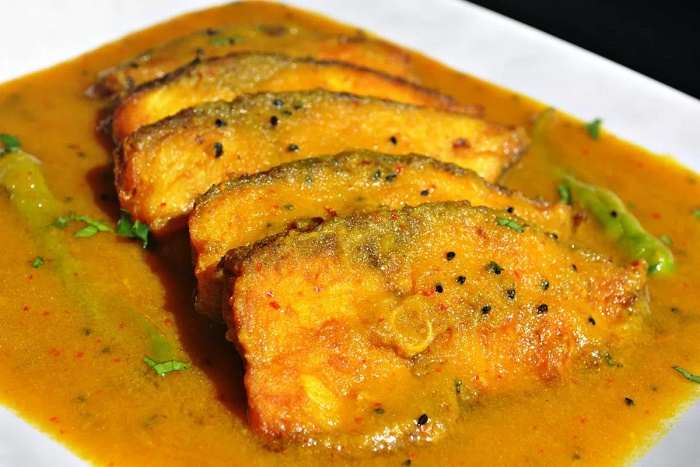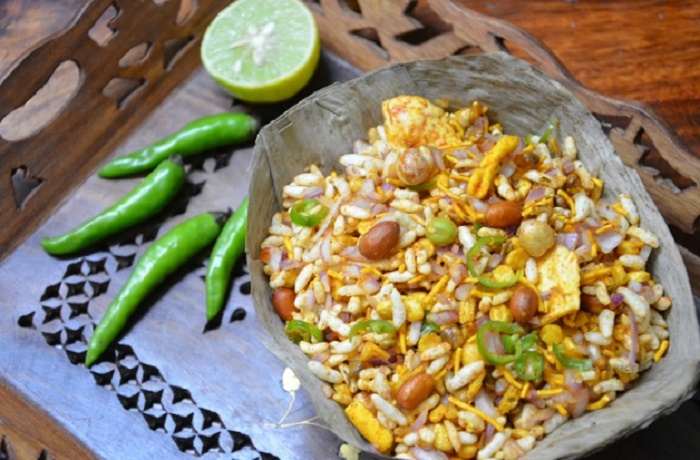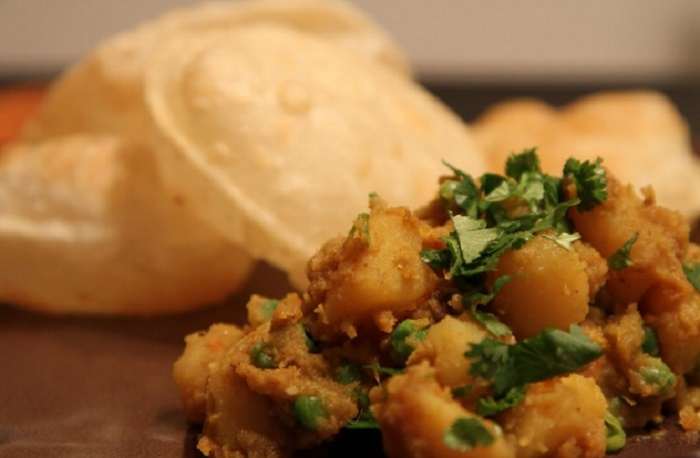
Image Credit: hungryforever.com
Bengali food that originated and evolved in the region of Bengal situated in the eastern subcontinent of India (presently divided into West Bengal in India and a separate nation called Bangladesh) is rich and varied in its platter starting from snacks to main courses to sweets. Although the food habits, tastes, preferences and choice of items vary with different districts, communities and religions, the basic course generally remains the same with rice and fish playing a dominant role. Probably this is why a Bengali is often typified as a ‘Maache-Bhaate-Bangali’ where Maach means fish and Bhaat means boiled rice in Bengali. A Bengali meal follows a multi-course tradition where food is served course-wise usually in a specific format, marking it as the only meal of the subcontinent to have evolved such convention. It is quite similar to the present day service à la russe style of French cuisine. Generally a Bengali meal starts with a ‘Shukto’ (a bitter preparation) followed by ‘Shak’ (leafy vegetables), Dal (pulses), variety of vegetables, fish/mutton/chicken/egg curry, chutney (sweet-sour saucy item) and ends with sweet dish like curd and other traditional sweets like sandesh or rosogolla. With time Bengalis have embraced different culinary influences as well including that of the Mughlas, Chinese and British subtly twisting these to suit their own taste-buds.
Availability of Different Products & Distinguishing Features of Bengali Food
Bengal, with rich cultivating land, has traditionally been an agrarian society. The practice of multi-cropping is quite common in Bengal which has earned a fame for producing varied and good quality rice. Variety of vegetables and fruits are grown here round the year. The coastline region is also abundant with rivers like the Ganges, Padma, Meghna, Damodar, Mayurakshi, Teesta and Rupnarayan among others and other water bodies like ponds and lakes that offer the populace a wide variety of fish like ruhi, katla, pabda, tangra, koi, hilsa, pomfret and bhetki and other sea animals like shrimp, prawn and crabs. Cattle primarily used for agriculture and dairy farming in the region are prime source of variety of dairy products in Bengal starting from ghee, butter, curd and a huge variety of sweet dishes. Traditionally ghee and mastered oil were used for cooking, however the former has now been replaced by refined oil by the more modern and health conscious Bengalis. However it still finds place in different delicacies and special items to enhance taste and although not quite often but is still savoured with hot rice. Thus the products cultivated and found regionally dominate the platter of a Bengali.
A daily meal of a Bengali comprise of various items served course-wise however is much simpler than the ones prepared during occasions and festivals. Fish, mutton, goat, chicken and eggs of chicken and ducks are usually consumed across Bengal while beef is consumed by the Muslim community. Mustard oil is mostly used in preparing different dishes barring a few delicacies. Use of whole black mustard seeds either as phoron or as a paste in different cuisines are also very much in league with Bengali dishes. Kashundi, a special sauce prepared out of mustard paste is savoured with Shak served with boiled rice and with different other fried items like fish fry.

Common Spices Used in Bengali Cuisine
A variety of spices and their mixes are used in preparing Bengali cuisine, the common ones being halud (turmeric), jira (cumin), dhone (coriander) radhuni (wild celery seeds), kalo jeera (black onion seeds), dried red chilli, bay leaves, shorshe (mustard), poshto (poppyseed), methi (fenugreek), mouri (fennel), peyaj (onion), ada (ginger), narikel (ripe coconut) and a combination of five spices called panch phoron which comprise of kalo jeera, cumin, black mustard seeds, fenugreek and fennel. Phoron that is frying the spices singly or in combinations either at the beginning of preparing a recipe or adding later to it plays a dominant role in Bengali cooking style. Use of whole black mustard seeds either as phoron or as a paste in different cuisines are also very much in league with Bengali dishes. Kashundi, a special sauce prepared out of mustard paste is savoured with Shak served with boiled rice and with different other fried items like fish fry.
Daily Meals of a Bengali Family
The Bengalis who are known to be foodies not only relishe different delicacies but also take pleasure in serving guests or ‘athithis’ who they consider as Narayan (Lord Vishnu). Kitchen not only marks an important spot in a Bengali household but also probably remains the busiest section of the house since dawn. The four meals throughout the day comprise the usual breakfast, lunch, snacks and dinner.

Breakfast
As rice plays a prominent role in a Bengali platter, it has its reflections in breakfast also – the form may differ though. Traditionally a usual day breakfast may comprise of rice in puffed form called ‘muri’, in beaten form called ‘chira’ or in fried form called ‘khoi’. Vegetables, milk and fruits are also consumed during breakfast. In rural areas the rice left over after dinner is kept in a pot with water in it which gets slightly fermented the next morning. This rice popularly called ‘pantha bhat’ is consumed as breakfast the next morning and is a very common form of breakfast in villages. Special wheat-based items like luchi (round and small in shape, deep-fried and puffed homemade bread), porota (triangular or round pan fried homemade bread with or without stuffing) and kochuri (stuffed luchi) served with hot dal or alurdum (a spicy and extremely luscious dish made of potato) are some of the items that are usually prepared during weekends, holidays or on special occasions. The stuffing can be different, but the most usual is peas and dal. However along with the traditional dishes Bengalis have also incorporated healthy and less time consuming breakfast items of the day such as oats and cornflakes among others.
Lunch/Dinner
The course-wise lunch or dinner more or less comprise of similar set of items such as dal, vegetables, non-veg items like fish or meat and desserts barring a few changes. While the meal starts with a preparation of bitter vegetables and herbs called shukto during lunch followed by shak or leafy vegetables like palong, and spinach among others these two items are usually avoided during dinner. Shukto, which is considered to have high medicinal value can be a simple fry of different forms of bitter gourd or herbs like neem, a mix of steamed bitter vegetables with boiled potato or a well prepared and delicious mixed vegetable containing these ingredients. The latter often remains a starter in many of the Bengali occasions. Shak is generally consumed in fried form and sometimes added in mixed vegetables as well.





